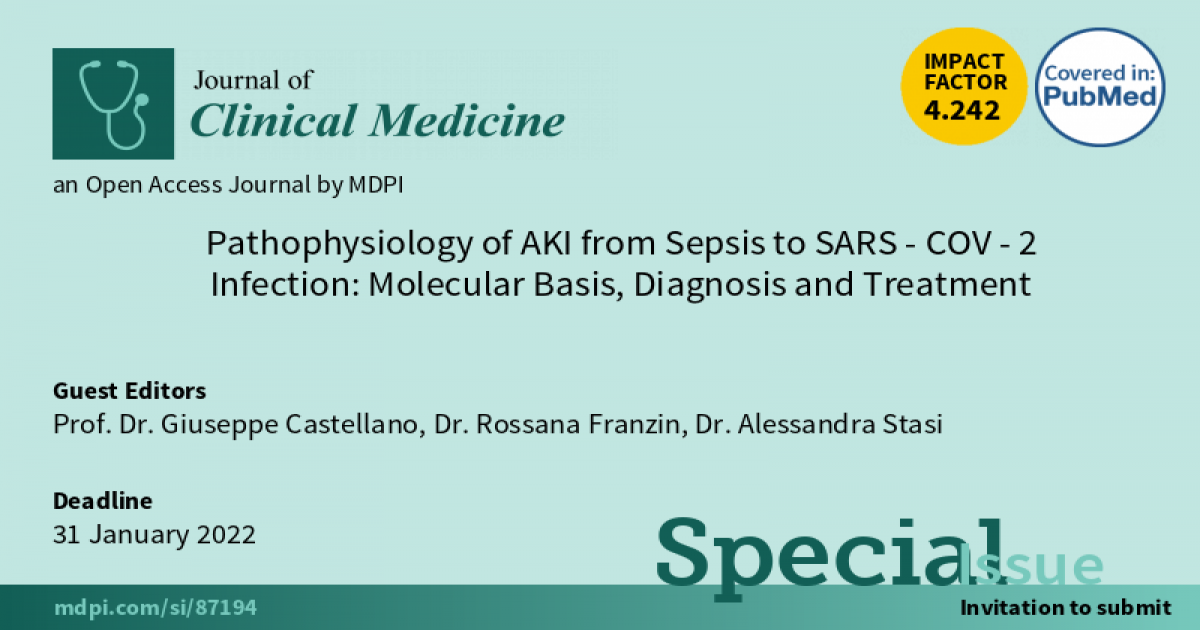Pathophysiology of AKI from Sepsis to SARS-COV-2 Infection: Molecular Basis, Diagnosis and Treatment
A special issue of Journal of Clinical Medicine (ISSN 2077-0383). This special issue belongs to the section "Nephrology & Urology".
Deadline for manuscript submissions: closed (31 March 2022) | Viewed by 9404

Special Issue Editors
Interests: acute kidney injury; sepsis, renal transplantation; complement system; fibrosis and aging; dendritic cells
Special Issues, Collections and Topics in MDPI journals
Interests: acute kidney injury; renal aging; complement system; renal transplantation; endothelial-to-mesenchymal transition
Special Issues, Collections and Topics in MDPI journals
Interests: sepsis; acute kidney injury; infection; molecular biology; animal studies; endothelial dysfunction; inflammation; complement system; fibrosis; aging
Special Issue Information
Dear Colleagues,
Sepsis remains a major cause of morbidity and mortality worldwide, with more than 11 million deaths annually. The syndrome represents a life-threatening systemic disease associated with an overwhelmed host response due to invasion of the bloodstream by bacteria, viruses, fungi, or parasites. Severe acute respiratory syndrome coronavirus 2 (SARS-CoV-2), the causal agent of coronavirus disease 2019 (COVID-19), shares common features with sepsis as multiorgan dysfunction and is currently defined as “viral sepsis”. In recent years, these systemic inflammatory disorders have attracted the interest of several researchers because of their involvement in human health.
In critically ill patients, renal dysfunction is associated with an unacceptably high morbidity/mortality risk, progression toward chronic kidney disease, and increased health resource utilization. Patients with acute kidney injury (AKI) are twice as likely to require invasive mechanical ventilation and renal replacement therapies. Given the paucity of knowledge about optimal prevention and treatment strategies for sepsis and COVID-19-related AKI, specific biological markers for an early and reliable diagnosis of AKI and response to therapies should be defined. This last point is crucial in the management of severe forms of sepsis and COVID-19 and may have an immediate application in our daily approach to these patients. In addition, pre-clinical studies with animal models and in vitro experiments should provide additional insights into the physiopathological aspects of these systemic inflammatory disorders. Exploring new pathogenetic mechanisms, with special regard to the role of soluble and cellular components of innate immunity, would identify novel targets and innovative therapeutic approaches.
In this Special Issue, we will gather original research papers and reviews from different experts in the field that bring to the forefront new advances in pathophysiology and treatment of sepsis and COVID-19-associated AKI.
Prof. Dr. Giuseppe Castellano
Dr. Rossana Franzin
Dr. Alessandra Stasi
Guest Editors
Manuscript Submission Information
Manuscripts should be submitted online at www.mdpi.com by registering and logging in to this website. Once you are registered, click here to go to the submission form. Manuscripts can be submitted until the deadline. All submissions that pass pre-check are peer-reviewed. Accepted papers will be published continuously in the journal (as soon as accepted) and will be listed together on the special issue website. Research articles, review articles as well as short communications are invited. For planned papers, a title and short abstract (about 100 words) can be sent to the Editorial Office for announcement on this website.
Submitted manuscripts should not have been published previously, nor be under consideration for publication elsewhere (except conference proceedings papers). All manuscripts are thoroughly refereed through a single-blind peer-review process. A guide for authors and other relevant information for submission of manuscripts is available on the Instructions for Authors page. Journal of Clinical Medicine is an international peer-reviewed open access semimonthly journal published by MDPI.
Please visit the Instructions for Authors page before submitting a manuscript. The Article Processing Charge (APC) for publication in this open access journal is 2600 CHF (Swiss Francs). Submitted papers should be well formatted and use good English. Authors may use MDPI's English editing service prior to publication or during author revisions.
Keywords
- sepsis
- SARS-CoV-2
- Acute Kidney Injury (AKI)
- experimental and clinical studies
- molecular mechanisms
- therapeutic targets
- emerging biomarkers
Benefits of Publishing in a Special Issue
- Ease of navigation: Grouping papers by topic helps scholars navigate broad scope journals more efficiently.
- Greater discoverability: Special Issues support the reach and impact of scientific research. Articles in Special Issues are more discoverable and cited more frequently.
- Expansion of research network: Special Issues facilitate connections among authors, fostering scientific collaborations.
- External promotion: Articles in Special Issues are often promoted through the journal's social media, increasing their visibility.
- e-Book format: Special Issues with more than 10 articles can be published as dedicated e-books, ensuring wide and rapid dissemination.
Further information on MDPI's Special Issue polices can be found here.






